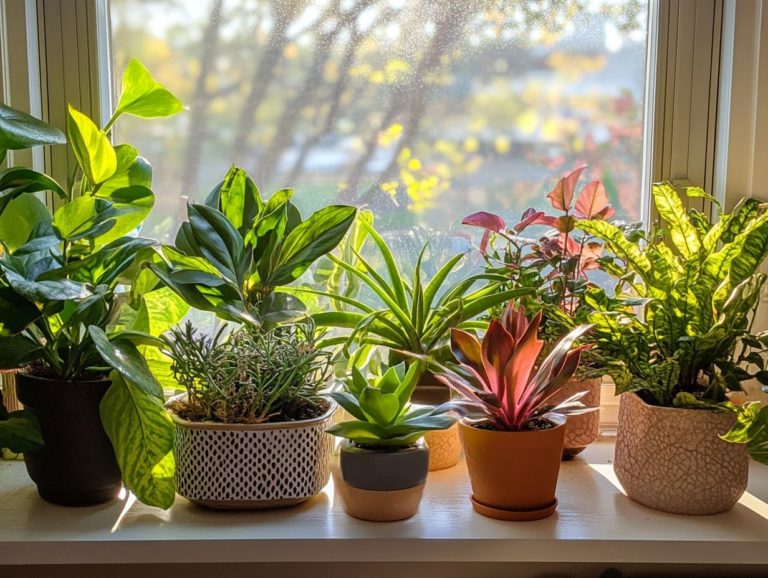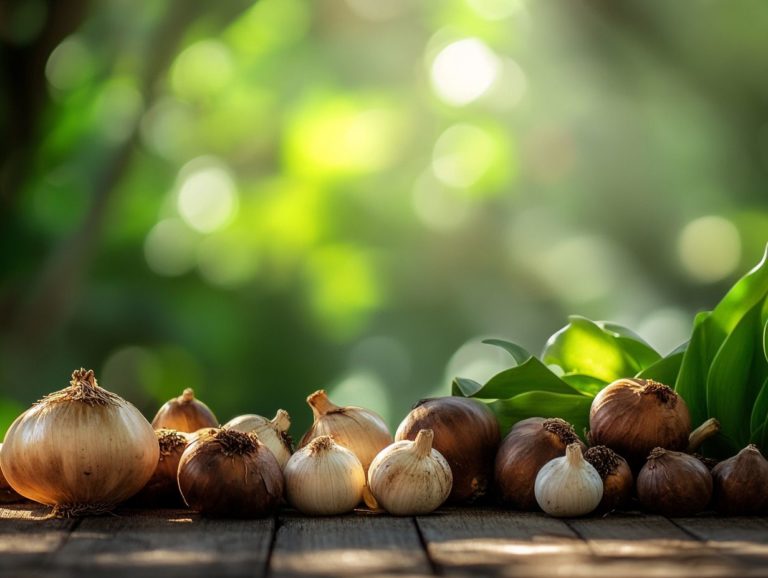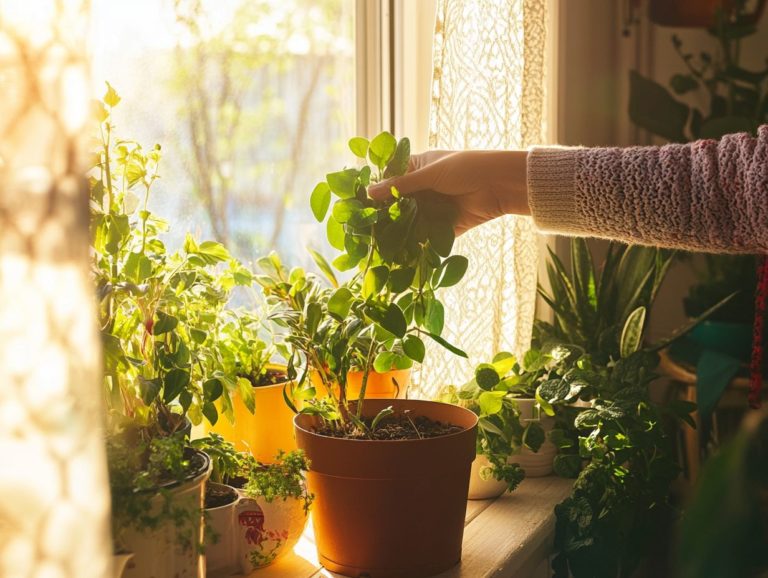Top 10 Grow Lights for Indoor Plants
Choosing the right grow lights can truly transform your indoor gardening experience. Ensuring your plants thrive in a healthy environment allows them to receive the best grow lights available.
With many options at your fingertips, it s vital for you to understand the nuances of various types of grow lights from LED to fluorescent and everything in between. Each type boasts its own distinct advantages.
In this article, you will find the best 10 grow lights. You will learn what sets them apart and explore crucial factors to consider as you make your selection, including effective lighting solutions and customizable options.
You will also find valuable gardening tips to enhance their effectiveness and insights into common pitfalls to avoid during your evaluation process.
Get ready to light up your indoor garden like never before!
Contents
- Key Takeaways:
- 1. LED Grow Lights
- 2. Fluorescent Grow Lights
- 3. High-Intensity Discharge (HID) Grow Lights
- 4. Metal Halide (MH) Grow Lights
- 5. High-Pressure Sodium (HPS) Grow Lights
- 6. Ceramic Metal Halide (CMH) Grow Lights
- 7. Plasma Grow Lights
- 8. Induction Grow Lights
- 9. Incandescent Grow Lights
- 10. Halogen Grow Lights
- What Are Grow Lights and Why Are They Important for Indoor Plants?
- What Are the Different Types of Grow Lights and How Do They Differ?
- What Are the Key Factors to Consider When Choosing a Grow Light?
- How Can Grow Lights Help with Plant Growth and Development?
- What Are the Common Mistakes to Avoid When Using Grow Lights?
- What Are Some Tips for Maximizing the Effectiveness of Grow Lights?
- Frequently Asked Questions
- What are the top 10 grow lights for indoor plants?
- What type of grow light is best for indoor plants?
- How do I choose the right grow light for my indoor plants?
- Do I need a grow light for all types of indoor plants?
- Can I use regular household light bulbs as grow lights for my indoor plants?
- Are there any benefits of using grow lights for indoor plants, like affordable grow lights or user-friendly options?
Key Takeaways:
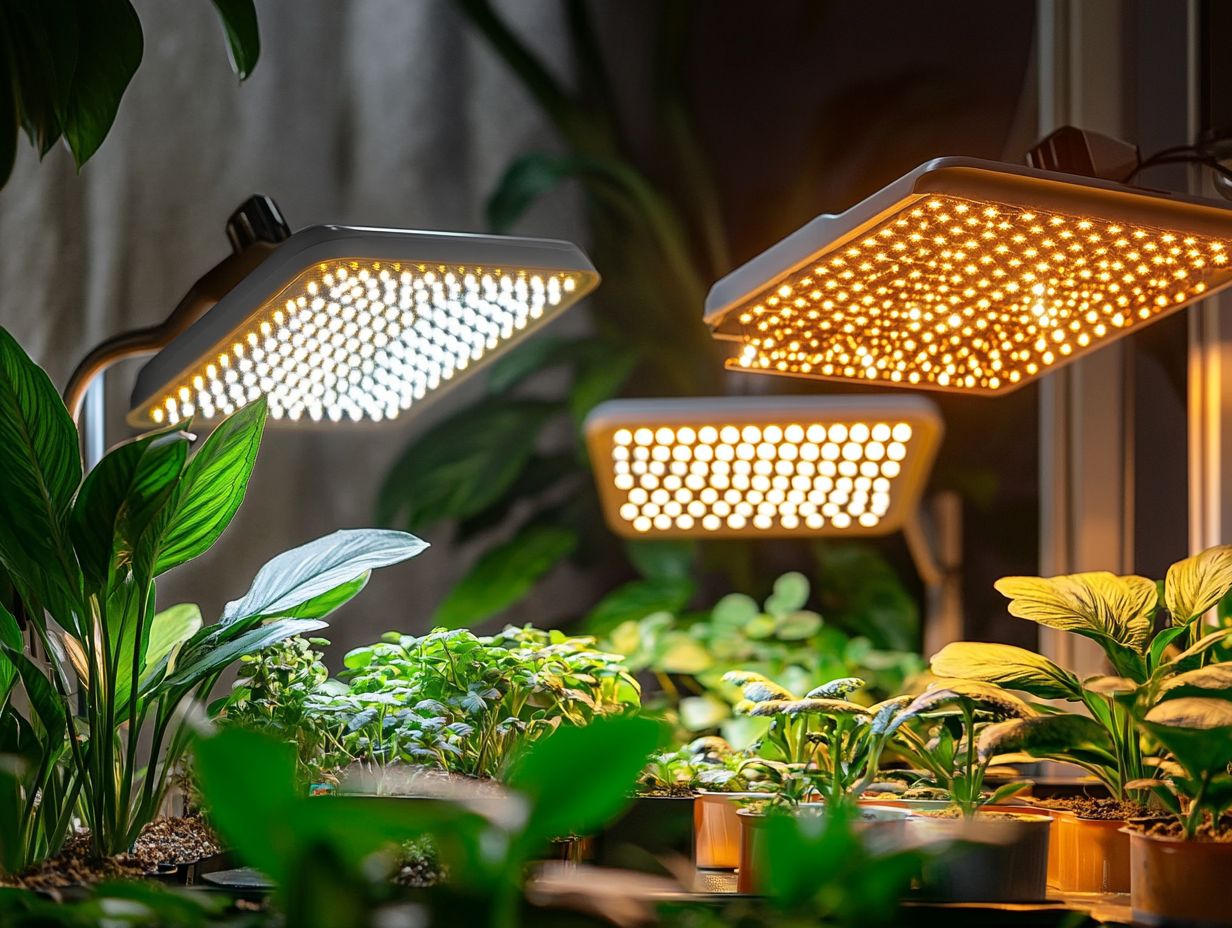
- LED grow lights are energy-efficient and long-lasting, making them a top choice for indoor plant growth, especially when you need full spectrum light for optimal plant health.
- HID (High-Intensity Discharge) lights, like Metal Halide and High-Pressure Sodium, provide intense light for larger plants.
- When choosing a grow light, consider factors such as light spectrum, wattage, and coverage area to ensure optimal growth conditions for your indoor plants.
1. LED Grow Lights
LED grow lights are changing indoor gardening. They offer an effective lighting solution that meets the specific needs of various plants, ensuring optimal health and growth.
With a full spectrum of light that mimics natural sunlight, you can customize light exposure to suit different planting conditions and growth stages. These innovative lights offer adjustable heights.
They also have dimmable features, allowing you to fine-tune the intensity and proximity of the light. This makes it effortless to cater to the unique requirements of both seedlings and mature plants.
Unlike traditional fluorescent or HID grow lights, LED options are far more energy-efficient and emit less heat, significantly lowering the risk of scorching your precious plants.
Customer reviews often praise the user-friendly ability to switch between spectral modes, enabling you to optimize light quality according to growth phases. Many users agree that the value for money offered by these lights is unmatched, elevating their gardening experience and promoting healthier, more vibrant plants.
2. Fluorescent Grow Lights
Fluorescent grow lights are often regarded as one of the most budget-friendly options for indoor gardening. They deliver efficient and effective lighting solutions that cater to your plants’ care and growth.
These lights come in various types, most notably T5 and T8 models, each designed to meet the specific needs of different indoor plants. T5 lights typically offer higher light intensity, making them perfect for heavy feeders and flowering plants. To choose the right plants for your setup, consider the top 5 indoor plants for natural light.
On the other hand, T8 lights provide a gentler glow, ideal for nurturing leafy greens and seedlings. With their low energy consumption, fluorescent grow lights emerge as an eco-conscious choice, enabling you to cultivate a thriving indoor garden without the fear of soaring electricity bills.
These fixtures represent an excellent combination of performance and affordability, making them a favored choice among urban gardeners.
3. High-Intensity Discharge (HID) Grow Lights
HID (High-Intensity Discharge) grow lights have become a staple for experienced indoor gardeners. They deliver an impressive light intensity that elevates plant growth and development.
You will find these lights in various types, including Metal Halide (MH) and High-Pressure Sodium (HPS), each tailored to meet specific needs throughout different growth phases. MH lights, with their blue spectrum, are perfect for the vegetative stage, helping your plants develop lush green foliage.
On the other hand, HPS lights emit a yellow-orange spectrum that shines during the flowering phase, providing the energy your budding plants crave.
To achieve optimal results, consider incorporating reflective surfaces and using timers to create a controlled environment. Setting up your grow lights requires essential tools like hangers, ducting for ventilation, and a reliable ballast but with this straightforward approach, even novices can achieve remarkable results.
4. Metal Halide (MH) Grow Lights
Metal Halide (MH) grow lights are celebrated for their exceptional light exposure, making them an excellent choice for fostering robust plant growth during the vegetative phase. These lights emit a balanced spectrum that includes both blue and white wavelengths, crucial for photosynthesis, significantly enhancing the overall health and vitality of your indoor plants.
When compared to other types of grow lights, like fluorescent and high-pressure sodium models, MH lights offer a versatile and focused light output that closely resembles natural sunlight. This unique spectral range allows your plants to thrive by promoting strong stem development and lush leaf growth, highlighting the importance of MH lights as a critical tool in your indoor gardening toolkit.
5. High-Pressure Sodium (HPS) Grow Lights
High-Pressure Sodium (HPS) grow lights are your go-to solution for effective lighting, particularly during the flowering stage of plant growth due to their rich red light spectrum. This warm white light closely mimics the natural sunlight that plants thrive on during late summer, emitting wavelengths that promote blooming and fruiting processes.
As an indoor grower, using HPS lights enables you to achieve bountiful yields. Compared to Metal Halide (MH) lights, which primarily deliver cooler blue light perfect for vegetative growth, HPS lights truly shine in fostering vibrant flowers and fruit. HPS systems are also more energy-efficient, converting electricity into usable light more effectively, making them a cost-effective choice for serious gardeners who aim to maximize both the quality and quantity of their harvests.
6. Ceramic Metal Halide (CMH) Grow Lights

Ceramic Metal Halide (CMH) grow lights offer a full spectrum of light that closely mimics natural sunlight. This makes them an exceptional choice for enhancing plant health and fulfilling their light requirements. What truly distinguishes these lights is their ability to provide a balanced spectrum, which enhances photosynthesis and significantly boosts overall plant vitality.
Unlike traditional MH and HPS options that often emit limited wavelengths, CMH lights promote a broader range of photosynthetically active radiation, leading to healthier growth, vibrant colors, and improved yields. CMH lights save you energy and money, making them a smart choice for any grower eager to optimize results.
7. Plasma Grow Lights
Plasma grow lights offer an exceptional solution for your indoor gardening endeavors, delivering a broad light spectrum that creates optimal conditions for plant growth while being portable and easy to set up. Their impressive longevity sets them apart from traditional options, boasting a lifespan that minimizes the need for frequent replacements.
This not only reduces maintenance costs but also enhances energy efficiency, a key consideration for eco-conscious gardeners. Easily integrated into various setups, from hydroponic systems to greenhouse environments, plasma lights guarantee your plants receive the precise light they need at every growth stage, ultimately promoting healthier and more productive yields.
8. Induction Grow Lights
Induction grow lights present an exceptional lighting solution for your indoor gardening endeavors. Renowned for their longevity and efficiency, these lights ensure consistent care for your plants through various growth cycles.
They offer a stable light source that closely mimics natural sunlight. This provides impressive energy savings compared to traditional lighting methods.
You can enjoy healthier plant growth without the burden of soaring electricity bills. With minimal maintenance needs like infrequent bulb replacements induction grow lights are the perfect hassle-free choice for any indoor plant enthusiast.
To truly maximize their benefits, it’s essential to position these lights at the right distance above your plants. This is especially important for delicate species like seedlings, which flourish under softer light exposure.
More mature plants often benefit from a slightly stronger intensity for optimal growth. Regularly monitoring the light duration and adjusting it according to your plants’ needs will further boost plant growth.
9. Incandescent Grow Lights
Incandescent grow lights might catch your eye as the most budget-friendly option for plant growth. They offer basic light exposure without breaking the bank, even if they aren’t the pinnacle of efficiency.
While these lights are certainly cost-effective, they leave much to be desired in energy efficiency. They convert only a fraction of energy into usable light, with the remainder escaping as heat.
This excess heat can ramp up your cooling needs and potentially harm delicate plants if they re placed too close. Many users report success with incandescent lights for germinating seeds or nurturing certain low-light plants.
However, they often fall short for high-yield, phototropic species that crave intense, specific light spectra. For novice growers on a tight budget or those in cooler climates, these lights can still serve a purpose.
They can warm up soil or provide extra illumination during those short winter days, making them a popular choice among affordable grow lights.
10. Halogen Grow Lights
Halogen grow lights present a sleek design and adjustable spectrum, delivering high light intensity that effectively supports the growth of various indoor plants.
These lights are especially beneficial for those eager to cultivate diverse species, allowing you to tailor the spectrum to meet specific needs. This significantly enhances photosynthesis.
Their portability adds to their practicality in indoor gardening, letting you easily reposition them according to your plants’ growth stages. When stacked against other grow lights like LEDs or fluorescents, halogen lights shine with superior brightness and can be an excellent option among the various types of grow lights for home use.
This brightness penetrates deeper into foliage to ensure even coverage. This functionality promotes healthier plants and accelerates growth cycles, making them an ideal choice for both novice and seasoned growers.
What Are Grow Lights and Why Are They Important for Indoor Plants?
Grow lights are your go-to artificial light sources that mimic natural sunlight. They play an essential role in indoor gardening by meeting the light requirements necessary for optimal plant growth and health.
These lights are a game-changer for urban gardeners or anyone lacking sufficient natural sunlight. They deliver the precise spectrum of light needed for photosynthesis.
Grow lights can significantly enhance plant growth rates, improve flowering, and boost crop yields. You ll find various types of grow lights available, including LED, fluorescent, and halide.
Each type offers distinct advantages. For instance, LED lights are energy-efficient and boast a long lifespan, while fluorescent lights provide a broad spectrum that’s perfect for nurturing seedlings.
By understanding these options, you can tailor your lighting to suit specific plants, optimizing growing conditions for lush, vibrant foliage.
What Are the Different Types of Grow Lights and How Do They Differ?
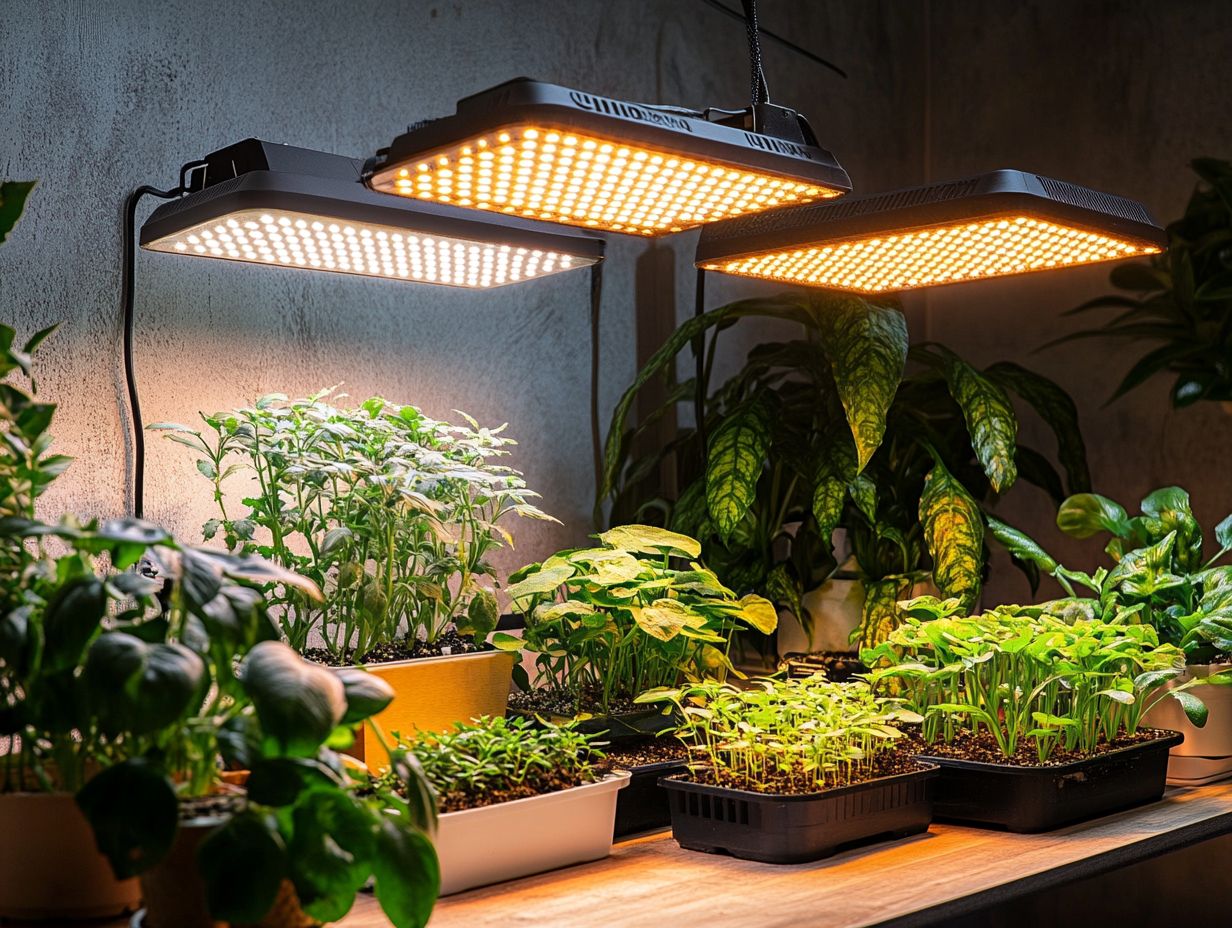
There s a whole array of grow lights out there LED, High-Intensity Discharge (HID), fluorescent, and more. Each type boasts unique features and benefits tailored to specific plant growth conditions.
Understanding the differences among these lights can significantly impact your plant growth. LED grow lights are known for their energy efficiency and long lifespan, making them a top choice for indoor gardeners.
HID lights provide intense brightness and power, ideal for commercial growers aiming for high yields. On the other hand, fluorescent lights offer a gentler glow, which is perfect for nurturing seedlings and small plants in their initial stages.
Each type of grow light delivers a distinct range of light colors, impacting photosynthesis and growth rates. This knowledge is essential for optimizing plant health throughout their development.
What Are the Key Factors to Consider When Choosing a Grow Light?
When selecting a grow light, several key factors demand your attention. These include light intensity, energy efficiency, and easy-to-use features that enhance your overall experience.
It s crucial to consider the light spectrum as well. Different plants thrive under varying wavelengths, which can significantly influence their growth and health.
Customization options allow you to tailor your lighting system to meet the specific needs of your plants. This aspect is essential for achieving optimal results.
Easy installation can save you valuable time, especially if you’re new to gardening. This ensures even beginners can benefit from effective lighting solutions.
Evaluating value for money will guide you in choosing a grow light that fits your budget while still delivering exceptional performance for your diverse gardening needs.
How Can Grow Lights Help with Plant Growth and Development?
Grow lights are essential for boosting plant growth and development. They provide the perfect light spectrum needed for photosynthesis and ensure optimal health throughout the lifecycle of indoor plants.
These artificial light sources mimic sunlight, enabling photosynthesis even where natural light is insufficient. You can find various types of grow lights, such as LEDs and fluorescent bulbs, each emitting different wavelengths tailored to specific plant needs. For those looking to enhance their indoor space, check out the top 10 indoor plants for artificial light.
For instance, red light promotes flowering and fruiting, making it ideal for plants like tomatoes and peppers. Meanwhile, blue light enhances leaf growth, particularly benefiting leafy greens such as spinach and lettuce.
Grasping these subtleties allows you to choose the best lighting options for your plants. This maximizes their vitality and yield, while also improving your overall gardening experience.
What Are the Common Mistakes to Avoid When Using Grow Lights?
Many indoor gardeners make simple mistakes that can hinder their plants’ growth. Common pitfalls include improper light exposure and a lack of attention to plant care.
To truly unlock the potential of indoor gardening, you need to understand light requirements better. Overlooking the specific light spectrum your plants need can lead to insufficient growth or even damage.
Positioning your lights too close or too far can disrupt the balance plants need to flourish. It s essential to invest in adjustable grow lights and regularly rotate your plants for even exposure.
Keep an eye on humidity and temperature to create the best conditions for your indoor garden. This attention to detail will help your garden thrive, bringing joy and beauty to your space.
What Are Some Tips for Maximizing the Effectiveness of Grow Lights?
Want to supercharge your gardening experience? Focus on key factors like light intensity, timing, and the distance from your plants. These elements are crucial for enhancing your overall gardening performance.
Incorporating these considerations leads to healthier plants and impressive results. Keep the right distance from your plants too close can scorch leaves, while too far may cause leggy growth.
Adjust the light’s intensity for different growth stages. Increase it during the flowering phase for better development. Regularly changing how long your lights are on mimics natural sunlight cycles and promotes better photosynthesis.
By being mindful of these adjustments, you can create an ideal environment for robust plant growth, utilizing the right gardening tools effectively.
Frequently Asked Questions
Here are some common questions about grow lights and how to use them effectively.
What are the top 10 grow lights for indoor plants?

The top 10 grow lights for indoor plants include LED grow lights, fluorescent grow lights, HID grow lights, incandescent grow lights, metal halide grow lights, high-pressure sodium grow lights, T5 fluorescent grow lights, compact fluorescent grow lights, ceramic metal halide grow lights, and full spectrum LED grow lights.
What type of grow light is best for indoor plants?
The best type of grow light for indoor plants is a full spectrum LED grow light. These lights mimic natural sunlight and provide a balanced spectrum of light ideal for all stages of plant growth.
How do I choose the right grow light for my indoor plants?
To choose the right grow light for your indoor plants, consider the type of plants you have, the size of your growing space, and your budget. Selecting a grow light with the appropriate spectrum and intensity for your plants’ specific needs is also essential.
Do I need a grow light for all types of indoor plants?
No, not all indoor plants require grow lights. Some plants, such as succulents and cacti, can thrive in low light conditions. However, if you want your plants to grow and thrive especially during the winter months a grow light can be beneficial.
Can I use regular household light bulbs as grow lights for my indoor plants?
No, regular household light bulbs are not suitable for indoor plants because they do not provide the proper spectrum and intensity of light that plants need to grow. It is best to use specialized grow lights, such as LED grow lights or smart grow lights, for optimal plant growth, especially in indoor gardening setups.
Are there any benefits of using grow lights for indoor plants, like affordable grow lights or user-friendly options?
Yes, several benefits come from using grow lights for indoor plants, including promoting healthy growth and development, enhancing plant health, and improving the overall appearance of your plants under optimal lighting conditions.

